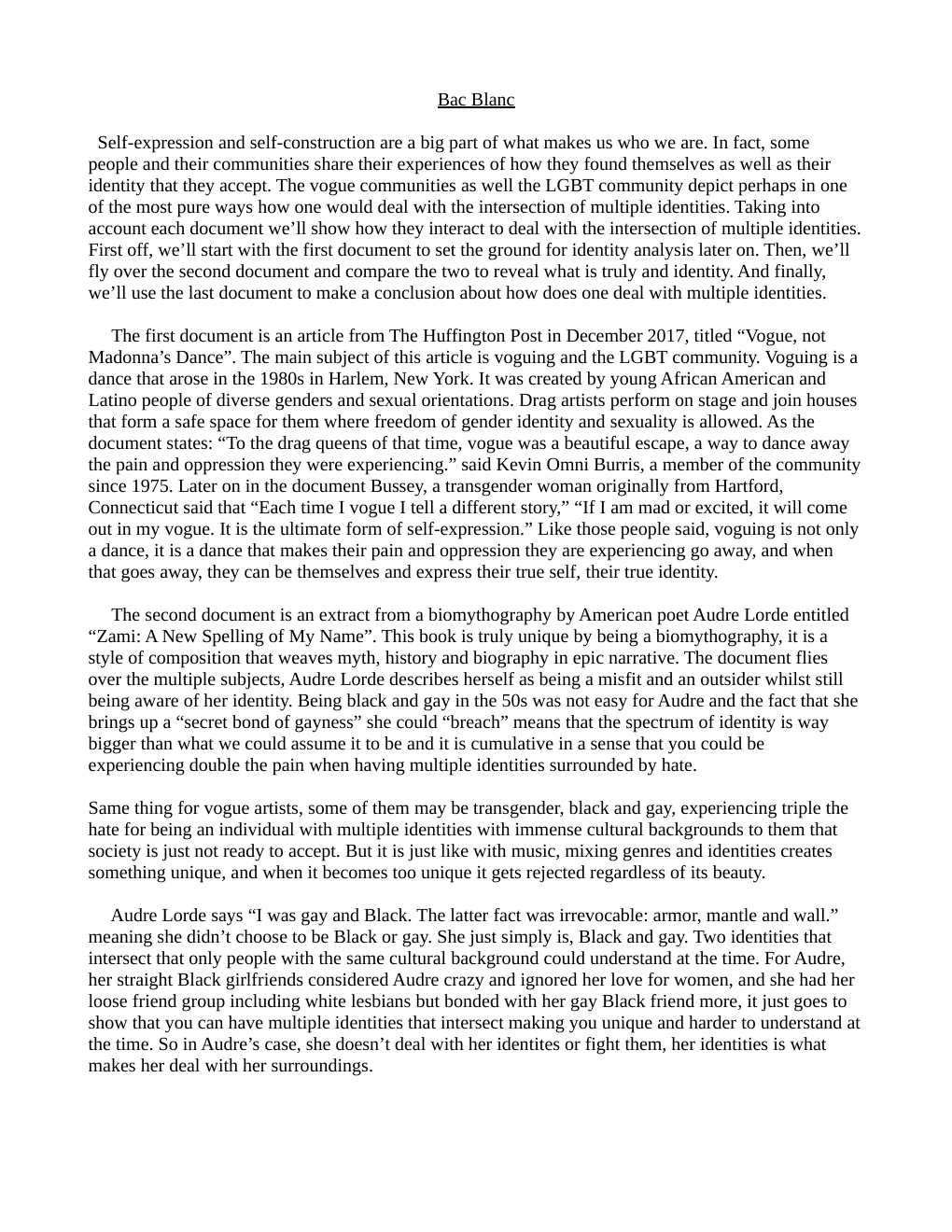How do the three documents interact to deal with the intersection of multiple identities?
Publié le 01/04/2022

Extrait du document
«
Bac Blanc
Self-expression and self-construction are a big part of what makes us who we are.
In fact, some
people and their communities share their experiences of how they found themselves as well as their
identity that they accept.
The vogue communities as well the LGBT community depict perhaps in one
of the most pure ways how one would deal with the intersection of multiple identities.
Taking into
account each document we’ll show how they interact to deal with the intersection of multiple identities.
First off, we’ll start with the first document to set the ground for identity analysis later on.
Then, we’ll
fly over the second document and compare the two to reveal what is truly and identity.
And finally,
we’ll use the last document to make a conclusion about how does one deal with multiple identities.
The first document is an article from The Huffington Post in December 2017, titled “Vogue, not
Madonna’s Dance”.
The main subject of this article is voguing and the LGBT community.
Voguing is a
dance that arose in the 1980s in Harlem, New York.
It was created by young African American and
Latino people of diverse genders and sexual orientations.
Drag artists perform on stage and join houses
that form a safe space for them where freedom of gender identity and sexuality is allowed.
As the
document states: “To the drag queens of that time, vogue was a beautiful escape, a way to dance away
the pain and oppression they were experiencing.” said Kevin Omni Burris, a member of the community
since 1975.
Later on in the document Bussey, a transgender woman originally from Hartford,
Connecticut said that “Each time I vogue I tell a different story,” “If I am mad or excited, it will come
out in my vogue.
It is the ultimate form of self-expression.” Like those people said, voguing is not only
a dance, it is a dance that makes their pain and oppression they are experiencing go away, and when
that goes away, they can be themselves and express their true self, their true identity.
The second document is an extract from a biomythography by American poet Audre Lorde entitled
“Zami: A New Spelling of My Name”.
This book is truly unique by being a biomythography, it is a
style of composition that weaves myth, history and biography in epic narrative.
The document flies
over the multiple subjects, Audre Lorde describes herself as being a misfit and an outsider whilst still
being aware of her identity.
Being black and gay in the 50s was not easy for Audre and the fact that she
brings up a “secret bond of gayness” she could “breach” means that the spectrum of identity is way
bigger than what we could assume it to be and it is cumulative in a sense that you could be
experiencing double the pain when having multiple identities surrounded by hate.
Same thing for vogue artists, some of them may be transgender, black and gay, experiencing triple the
hate for being an individual with multiple identities with immense cultural backgrounds to them that
society is just not ready to accept.
But it is just like with music, mixing genres and identities creates
something unique, and when it becomes too unique it gets rejected regardless of its beauty.
Audre Lorde says “I was gay and Black.
The latter fact was irrevocable: armor, mantle and wall.”
meaning she didn’t choose to be Black or gay.
She just simply is, Black and gay.
Two identities that
intersect that only people with the same cultural background could understand at the time.
For Audre,
her straight Black girlfriends considered Audre crazy and ignored her love for women, and she had her
loose friend group including white lesbians but bonded with her gay Black friend more, it just goes to
show that you can have multiple identities that intersect making you unique and harder to understand at
the time.
So in Audre’s case, she doesn’t deal with her identites or fight them, her identities is what
makes her deal with her surroundings..
»
↓↓↓ APERÇU DU DOCUMENT ↓↓↓
Liens utiles
- the handmaid's tale: How far do you agree that Margaret Atwood makes resistance central to THT?
- How Is Britain Dealing With Its Identity Crisis ?
- How did Roosevelt address the challenges of the Great Depression ?
- Inde, avril 2006, série L, LV1: Tracy Chevalier, The Girl With A Pearl Earring, 2000.
- What are the influences of the Gilead society and how they have an impact on the woman’s lives?


